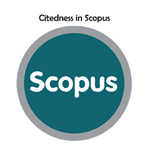Activity of a Gel Combination of Aloe Vera (Aloe Vera (L) Burm.F.) and Snail Mucus (Achatina fulica (Ferussac, 1821)) on Burn Wounds in Male White Rats (Rattus norvegicus) Wistar Strains
Abstract
Keywords
Full Text:
PDFReferences
P. A. Z. Hasibuan et al., "Antimicrobial and antihemolytic properties of a CNF/AgNP-chitosan film: A potential wound dressing material" Heliyon, vol. 7, no. 10, p. e08197, 2021.
A. Prayoga, "Aktivitas Antioksidan Ekstrak N-Heksan, Etilasetat, dan Etanol Daun Pirdot (Saurauia vulcani, Korth) dengan Metode Pemerangkapan DPPH" 2018.
P. RSP and S. AISIYAH, "Formulasi Gel Kombinasi Lendir Bekicot (Achatina fulica Ferr) dan Lidah Buaya (Aloe vera) sebagai Bahan Aktif untuk Terapi Luka Bakar Gel Formulation Combination Snail Slime (Achatina fulica Ferr) and Aloe vera as Active Material for Treatment of Burn."
A. Prayoga, Pengujian Patch Nanopartikel Perak Kitosan Dengan Pembawa Nanoserat Selulosa Terhadap Penyembuhan Luka Eksisi Pada Tikus Hiperglikemia, vol. 3, no. 2. Universitas Sumatera Utara, 2021.
A. Prayoga, "Comparison Study of Caffeine Levels of Coffee Bean ( Coffea Sp .) and Brands of Coffee Powder Circulate in Banda Aceh City" vol. 3, no. 1, pp. 96-102, 2023, doi: 10.37311/ijpe.v3i1.18913.
V. K. Sugiaman, "Peningkatan penyembuhan luka di mukosa oral melalui pemberian Aloe vera (Linn.) secara topical" Maranatha J. Med. Heal., vol. 11, no. 1, p. 151777, 2011.
A. Prayoga and P. A. Z. Hasibuan, "Synthesis of Silver Nanoparticles for Antibacterial Activity against Staphylococcus Aureus and Escherichia Coli" Asian J. Pharm. Res. Dev., vol. 9, no. 5, pp. 67-73, 2021.
F. Shoviantari, S. Fajriyah, E. Agustin, and S. Khairani, "UJI AKTIVITAS GEL LENDIR BEKICOT (Achatina fulica) SEBAGAI PENYEMBUHAN LUKA SAYAT" As-Syifaa J. Farm., vol. 13, no. 1, pp. 12-19, 2021.
A. Prayoga, R. Fitri, G. Anastasia, and H. D. Syahputra, "Evaluasi Perencanaan Obat Di Puskesmas Tanah Tinggi , Kecamatan Binjai Timur , Kota Binjai Tahun" vol. 01, no. 01, pp. 69-75, 2023.
P. A. Z. Hasibuan et al., "Antimicrobial And Antihemolytic Properties Of A Cnf/Agnp-Chitosan Film: A Potential Wound Dressing Material" Heliyon, vol. 7, no. 10, p. e08197, 2021, doi: 10.1016/j.heliyon.2021.e08197.
S. Tambunan and T. N. S. Sulaiman, "Formulasi gel minyak atsiri sereh dengan basis HPMC dan Karbopol" Maj. Farm., vol. 14, no. 2, pp. 87-95, 2018.
E. D. Marbun, A. Prayoga, and A. Y. Sianipar, "Edukasi Pemanfaatan Suplemen Kesehatan Di lingkungan SD Negeri 053975 Stabat Lama Kabupaten langkat" vol. 3, pp. 331-337, 2022.
S. Ahn et al., "Soy Protein/Cellulose Nanofiber Scaffolds Mimicking Skin Extracellular Matrix for Enhanced Wound Healing" Adv. Healthc. Mater., vol. 7, no. 9, 2018, doi: 10.1002/adhm.201701175.
A. Prayoga, "Forte jurnal" Forte J., vol. 02, no. 01, pp. 67-73, 2022.
E. D. Marbun, A. Prayoga, and A. Y. Sianipar, "Edukasi Pemanfaatan Suplemen Kesehatan Di Lingkungan SD Negeri 053975 Stabat Lama Kabupaten Langkat" J. Abdimas Mutiara, vol. 3, no. 2, pp. 331-337, 2022.
DOI: https://doi.org/10.37311/ijpe.v3i2.19343
Refbacks
- There are currently no refbacks.
Copyright (c) 2023 Artha Yuliana Sianipar, Andre Prayoga

Indonesian Journal of Pharmaceutical Education is licensed under a Creative Commons Attribution-NonCommercial-ShareAlike 4.0 International License.




